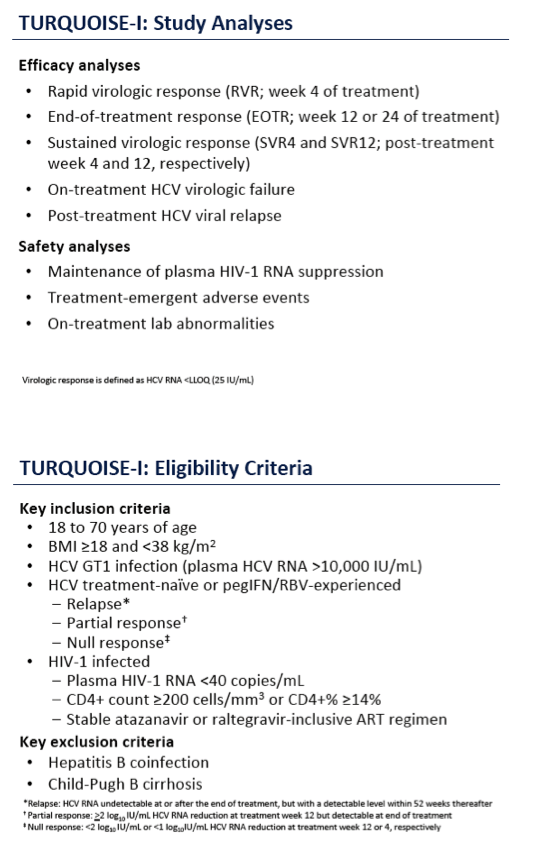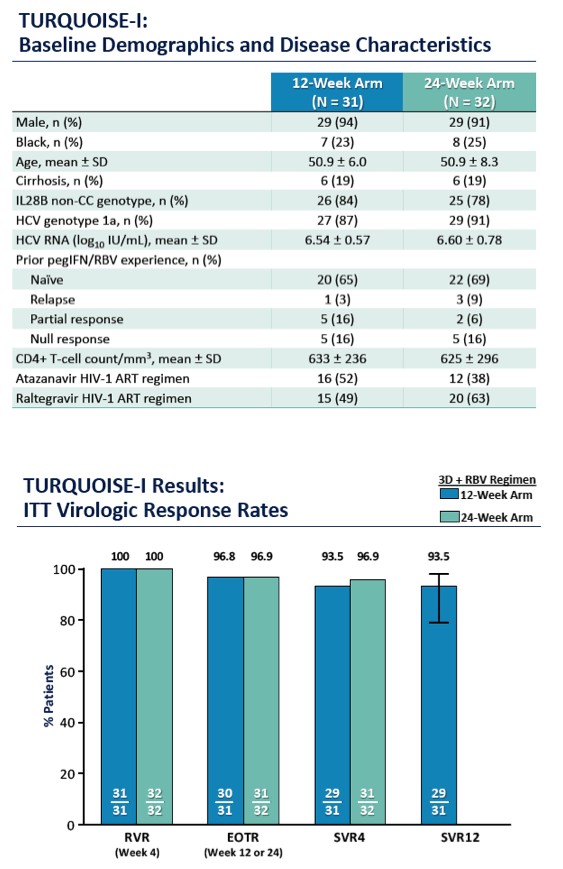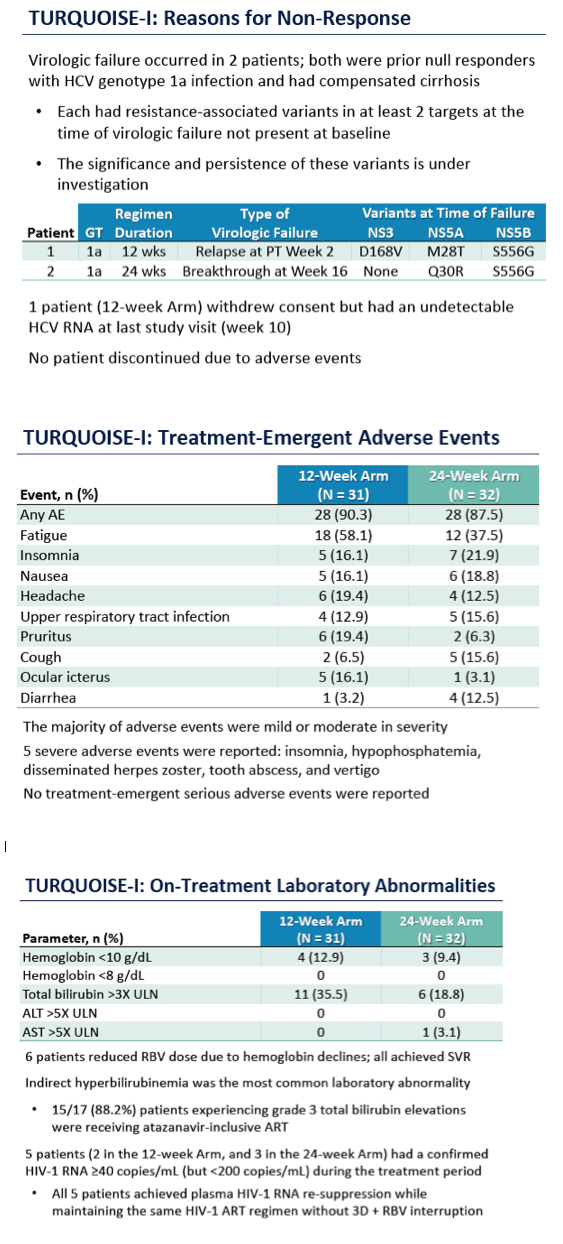 |
 |
 |
| |
High Response Rates With Triple-DAA Regimen in People With HCV and HIV: Abbvie 3D - ABT-450/ritonavir, ombitasvir, and dasabuvir, with ribavirin
|
| |
| |
20th International AIDS Conference, July 20-25, 2014, Melbourne
Mark Mascolini
Combining the direct-acting antivirals (DAAs) ABT-450/ritonavir, ombitasvir, and dasabuvir, with ribavirin, yielded high 4- and 12-week sustained virologic response (SVR) rates in people coinfected with HCV genotype 1 and HIV--with or without HCV treatment experience [1]. The findings add to evidence that interferon-free regimens control HCV in patients with HIV as effectively as in those without HIV.
ABT-450 is an HCV NS3/4A protease inhibitor, ombitasvir inhibits the HCV NS5A replication complex, and dasabuvir is a nonnucleoisde NS5B polymerase inhibitor. Previous research found high response rates with these three HCV drugs--with or without ribavirin--in HCV-monoinfected people with [2] or without [3] HCV treatment experience. A coformulated combination of ABT-450/ritonavir and ombitasvir is in licensing review.
To determine the impact of this 3-DAA combination on HCV genotype 1 in people with HIV infection, TURQUOISE-I investigators focused on HCV treatment-naive adults or those with only pegylated interferon/ribavirin experience. Study participants had CD4 count at or above 200 or a CD4 percent at or above 14% and an HIV load below 40 copies with an atazanavir- or raltegravir-based regimen [1,4]. Enrollees could have Child-Pugh class A cirrhosis.
This part of TURQUOISE-I enrolled 63 HCV/HIV-coinfected people and randomized them to take the 3 DAAs plus ribavirin for 12 weeks or 24 weeks. Fifty-eight participants (92%) were men, and 15 (24%) were black. Fifty-six study participants (89%) carried HCV genotype 1a, 12 (19%) had cirrhosis, and 42 (67%) had no HCV treatment experience. CD4 counts averaged 633 in the 12-week arm and 625 in the 24-week arm.
Among 31 people taking the three DAAs with ribavirin for 12 weeks, 31 had a rapid virologic response (RVR) at week 4, 30 (97%) had an end-of-treatment response (EOTR), 29 (93.5%) had an undetectable HCV load 4 weeks after treatment stopped (SVR4), and 29 (93.5%) attained SVR12. One participant withdrew consent before completing treatment but had an undetectable HCV load at week 10. One patient had a virologic relapse 2 weeks after treatment ended.
Among 32 participants taking three DAAs plus ribavirin for 24 weeks, 32 achieved RVR, 31 (97%) attained EOTR, and 31 (97%) attained SVR4. So far no one in the 24-week arm relapsed after treatment stopped and 19 of 20 (95%) have achieved SVR12.
Two virologic failures, one in each arm, both involved null responders with genotype 1a infection and compensated cirrhosis. Both patients had resistance mutations involving at least two HCV drug targets at failure but not at baseline.
No one stopped treatment because of adverse events. There were no serious adverse events and five severe adverse events: insomnia, hypophosphatemia, disseminated herpes zoster, tooth abscess, and vertigo. The most frequent adverse events were fatigue, insomnia, nausea, and headache. Elevated total bilirubin, the most common lab abnormality, primarily affected people taking atazanavir. Six people lowered their ribavirin dose because of declining hemoglobin and all achieved SVR.
The TURQUOISE-I investigators concluded that the high response rates seen so far in these HCV/HIV-coinfected people are consistent with rates seen in people infected only with HCV. In the next part of the trial, people on a stable darunavir regimen will take these three DAAs plus ribavirin for 12 weeks. Part 2 of TURQUOISE-I will be a multicenter international trials in which some subpopulations will take the three DAAs without ribavirin.
References
1. Sulkowski M, Eron JJ, Wyles D, et al. TURQUOISE-I: safety and efficacy of ABT-450/r/ombitasvir, dasabuvir, and ribavirin in patients co-infected with hepatitis C and HIV-1. AIDS 2014. 20th International AIDS Conference. July 20-25, 2014. Melbourne. Abstract MOAB0104LB.
2. Andreone P, Colombo MG, Enejosa JV, et al. ABT-450, ritonavir, ombitasvir, and dasabuvir achieves 97% and 100% sustained virologic response with or without ribavirin in treatment-experienced patients with HCV genotype 1b infection. Gastroenterology. 2014 pii: S0016-5085(14)00603-9.
3. Ferenci P, Bernstein D, Lalezari J, et al. ABT-450/r-ombitasvir and dasabuvir with or without ribavirin for HCV. N Engl J Med. 2014;370:1983-1992.
4. ClinicalTrials.gov. A study to evaluate the safety and efficacy of ABT-450/ritonavir/ABT-267 (ABT-450/r/ABT-267) and ABT-333 coadministered with ribavirin (RBV) in adults with genotype 1 chronic hepatitis C virus (HCV) infection and human immunodeficiency virus, type 1 (HIV-1) coinfection (TURQUOISE-I). http://clinicaltrials.gov/ct2/show/NCT01939197
----------------------------
TURQUOISE-I: SAFETY AND EFFICACY OF ABT-450/R/OMBITASVIR, DASABUVIR, AND RIBAVIRIN IN PATIENTS CO-INFECTED WITH HEPATITIS C AND HIV-1
Reported by Jules Levin
Mark S. Sulkowski, Joseph J. Eron, David Wyles, Roger Trinh, Jay Lalezari, Jihad Slim, Joseph Gathe, Peter J. Ruane, Chia Wang, Richard Elion, Fritz Bredeek, Robert Brennan, Gary Blick, Amit Khatri, Krystal Gibbons, Yiran B. Hu, Linda Fredrick, Tami Pilot-Matias, Barbara Da Silva-Tillmann, Barbara McGovern, Andrew L. Campbell, Thomas Podsadecki





|
| |
|
 |
 |
|
|